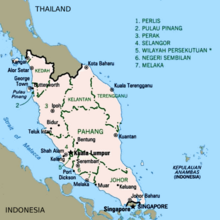Peninsular Malaysia
Coordinates: 4°0′N 102°30′E / 4.000°N 102.500°E / 4.000; 102.500

Landsat false-colour mosaic of Peninsular Malaysia.
Peninsular Malaysia also known as Malaya or West Malaysia, is the part of Malaysia which lies on the Malay Peninsula and surrounding islands. Its area is 132,265 square kilometres (51,068 sq mi), which is nearly 40% of the total area of the country - 330,611 square kilometres (127,650 sq mi) - or slightly smaller than England and Java island. It shares a land border with Thailand in the north. To the south is the island of Singapore.[1]
Across the Strait of Malacca to the west lies the Sumatra Island (Indonesia) and across the South China Sea to the east lies the Natuna Islands (Indonesia). Peninsular Malaysia accounts for the majority (roughly 81.3%) of Malaysia's population and economy; as of 2017 its population is roughly 26 million (92% of total population).
Contents
1 States and territories
2 Etymology
3 Demographics
4 Other features
4.1 East Coast and West Coast
4.2 West and East Malaysia
5 See also
6 References
7 External links
States and territories

A map of Malaya.
Peninsular Malaysia consists of the following 11 states and two federal territories (starting from the North going to the South):
Northern Region: Perlis, Kedah, Penang, Perak
East Coast Region: Kelantan, Terengganu, Pahang
Central Region: Selangor, federal territories of Kuala Lumpur and Putrajaya
Southern Region: Negeri Sembilan, Malacca, Johor
Etymology

The topography of Peninsular Malaysia.
Peninsular Malaysia is also known as West Malaysia (Malaysia Barat) or the States of Malaya (Negeri-negeri Tanah Melayu).[2][3]
Demographics
Ethnicity in Peninsular Malaysia (2017)
Bumiputera (Malay) (64.3%)
Chinese (25.1%)
Indian (9.0%)
Indigenous (Aslian) / Non - Malay Bumiputera (0.5%)
Others (1.1%)
The majority of people on Peninsular Malaysia are ethnic Malays, predominantly Muslim.[4] Large Chinese and Indian populations exist. The Orang Asli are the indigenous people of Peninsular Malaysia; they number around 140,000 and mostly lived in inland parts of the region.[citation needed]
Other features
East Coast and West Coast
The term East Coast is particularly used in Malaysia to describe the following states in Peninsular Malaysia facing the South China Sea, a component of the Pacific Ocean:
- Kelantan
- Pahang
- Terengganu
The term West Coast refers informally to a collection of states in Peninsular Malaysia situated towards the western coast generally facing the Strait of Malacca which is a component of the Indian Ocean, as opposed to the East Coast. Unlike the East Coast, the West Coast is partitioned further into three regions (as seen in #States and territories), including:
- The Northern Region: Perlis, Kedah, Penang and Perak.
- The Central Region: Selangor and the federal territories of Kuala Lumpur and Putrajaya.
- The Southern Region: Negeri Sembilan, Melaka and Johor.
Even though Johor has a coastline facing the South China Sea on the Pacific Ocean, it is not generally regarded as an East Coast state, since the main coastline of the state is located on the Straits of Johor of the Indian Ocean.
West and East Malaysia
The distinction between West and East Malaysia (Sabah and Sarawak) is significant beyond the sphere of geography, because as well as they were separate regions before the formation of The Federation of Malaysia, thus having a different court structure, and the eastern states have more autonomy than the original States of Malaya, for example, autonomy in immigration. These rights were granted as part of Sarawak's 18-point agreement and Sabah's 20-point agreement with Federation of Malaya in forming the Federation of Malaysia.
See also
- Malaya (disambiguation)
- Malayan dollar
References
^ "Malaya"..mw-parser-output cite.citation{font-style:inherit}.mw-parser-output q{quotes:"""""""'""'"}.mw-parser-output code.cs1-code{color:inherit;background:inherit;border:inherit;padding:inherit}.mw-parser-output .cs1-lock-free a{background:url("//upload.wikimedia.org/wikipedia/commons/thumb/6/65/Lock-green.svg/9px-Lock-green.svg.png")no-repeat;background-position:right .1em center}.mw-parser-output .cs1-lock-limited a,.mw-parser-output .cs1-lock-registration a{background:url("//upload.wikimedia.org/wikipedia/commons/thumb/d/d6/Lock-gray-alt-2.svg/9px-Lock-gray-alt-2.svg.png")no-repeat;background-position:right .1em center}.mw-parser-output .cs1-lock-subscription a{background:url("//upload.wikimedia.org/wikipedia/commons/thumb/a/aa/Lock-red-alt-2.svg/9px-Lock-red-alt-2.svg.png")no-repeat;background-position:right .1em center}.mw-parser-output .cs1-subscription,.mw-parser-output .cs1-registration{color:#555}.mw-parser-output .cs1-subscription span,.mw-parser-output .cs1-registration span{border-bottom:1px dotted;cursor:help}.mw-parser-output .cs1-hidden-error{display:none;font-size:100%}.mw-parser-output .cs1-visible-error{font-size:100%}.mw-parser-output .cs1-subscription,.mw-parser-output .cs1-registration,.mw-parser-output .cs1-format{font-size:95%}.mw-parser-output .cs1-kern-left,.mw-parser-output .cs1-kern-wl-left{padding-left:0.2em}.mw-parser-output .cs1-kern-right,.mw-parser-output .cs1-kern-wl-right{padding-right:0.2em}
^ Mohamed Anwar Omar Din (2012). "Legitimacy of the Malays as the Sons of the Soil". Canadian Center of Science and Education. pp. 80–81. ISSN 1911-2025.
^ Reid, Anthony (2010). Imperial alchemy : nationalism and political identity in Southeast Asia. Cambridge University Press. p. 95. ISBN 978-0-521-87237-9.
^ "Some aspects of Malay-Muslim Ethnicity in Malaya". June 1981. JSTOR 25797648.
External links
![]() Media related to Peninsular Malaysia at Wikimedia Commons
Media related to Peninsular Malaysia at Wikimedia Commons
 Peninsular Malaysia travel guide from Wikivoyage
Peninsular Malaysia travel guide from Wikivoyage
